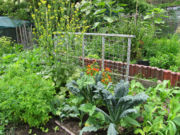Food/Permaculture
Most food now produced in the industrialized world comes from large farms that focus on just one or two crops or animals. This kind of farming requires constant inputs: fertilizer, pesticide, water and other resources. It also produces a constant output of pesticide-contaminated water and other waste.
By contrast, agroecology creates an interconnected system of flora and fauna that recycles its own resources. It is an multi-species ecosystem rather than a factory-style production outfit. Each species' needs of pest management, fertilization, animal feed and so on are provided by another species. The waste of one organism benefits another, thus elegantly solving the problems of waste management and nutrition in one solution. There is (theoretically at least) no waste, allowing the system to be 'permanent', able to go on for millenia without adversely affecting the local ecosystem.
Schools of agroecology include permaculture, biodynamic farming, biointensive farming and the Fukuoka method.
It is sometimes assumed that growing food without fertilizers, pesticides or other chemicals that have unwanted consequences means growing them without any yield-increasing methods at all [1]. According to this argument, we need higher yields to feed a growing population, and we need chemicals to boost yields; organic agriculture is equated with low-yielding agriculture. However, there is an alternative farming method that is both high-yielding and organic: agroecology, which uses ecological methods instead of chemical ones to boost yields.
Many experts have stressed that to sustain a growing population in a way that is viable in the long-term, we need is sustainable intensification [2][3][4]. This refers to a method of agriculture that gives higher yields than industrial monoculture, has less impact on the environment, uses less water and requires fewer inputs. Happily, sustainable agricultural practices also tend to be more productive than non-sustainable ones. An analysis of 286 sustainable farming projects in the developing world found that yields doubled for most plants [5]. Agroecological methods are key to sustainable intensification.
Sustainable intensification is being implemented all over the world, with a 50% increase in four years [6], and with entire countries like Cuba and Bhutan moving to sustainable systems. Several sustainable, yet intensive, food-production methods are explored below.
Industrial-style farming techniques deplete 6-24 kilos of soil for ever kilo of food grown [7]. This is a perfect example of a failure to think long-term; growing food in a way that diminishes the land's capacity to grow food is like killing the goose that lays the golden eggs. Permaculture (as its name suggests), focuses on the long-term fertility of the soil. Permaculture can create 20 kilos of newly fertile soil for every kilo of food grown[8].
Agroecology is not only an ecologically sound means of food-production, it is very productive. Permaculture expert David Blume makes a convincing case for the productivity of permaculture, writing, "In a good but somewhat sloppy design, you need about 500 square feet (46.5m2) per person maximum. In a very good design, 200 square feet (18.5m2) will do the job." John Jeavons (father of another school of permaculture called biointensive agriculture), makes more conservative claims of around 316-372 square meters [9] [10].
The 2011 UN report on the right to food notes that agroecology initiatives typically double yield within ten years while reducing the need for inputs like fertilizer. It also reports that agroecology projects generally come about as a result of peer-to-peer collaborative sharing of farming knowledge.
Permaculture uses such techniques as soil cultivation, plant-animal symbiosis, agroforestry, water harvesting, no-till farming and integrated pest management to create a productive system in which all agricultural processes are taken care of by the dynamic interaction of the parts of the system. This reduces labour considerably, as there is no need to till fields, spray crops or irrigate. Once soil fertility has built up to a certain level, it becomes unnecessary to spread fertilizer. In theory, a productive ecosystem, once established, can run without human labour. In the same way that a factory that uses robots to do most tasks can move towards automation, so a farm can move towards automation by getting other species to do most of the work: ducks take care of pests, nitrogen-fixing plants do the work of a fertilizer and pigs cultivate the soil.
The argument is often made that it requires 16 kilos of grain to produce one kilo of beef, so to preserve food and avoid a food crisis, we must all become vegetarian [11]. Agroecology bypasses this difficulty, because in an agroecosystem cows eat grass. Grass is not edible by humans, so no useful food resources are being wasted, and beef from grass-fed cows has a better nutritional profile than from grain-fed animals[12]. Cows also convert grass to meat much more efficiently than they convert grain[13]. Similar logic applies to other kinds of meat; the purposes of animals in agroecology is to convert inedible grasses, insects, leaves etc. into meat. If we are to build a food system that provides high-quality food to all of humanity, it is essential that we use the 335.7 trillion m2 of pasture available to us for raising meat sustainably by converting these inedible grasses into meat. One estimate is that this would provide enough food for 1.3 billion people[14].
While not as automated nor as productive as the aeroponics techniques described to the left, agroecology is a highly practical and advanced methodology that can play a role in making Spaceship Earth work for everybody. In time, it may become possible to automate agroecology by using sensors to detect when plants are ready for harvest, and having robots that can pick vegetables, prune trees and so forth.
